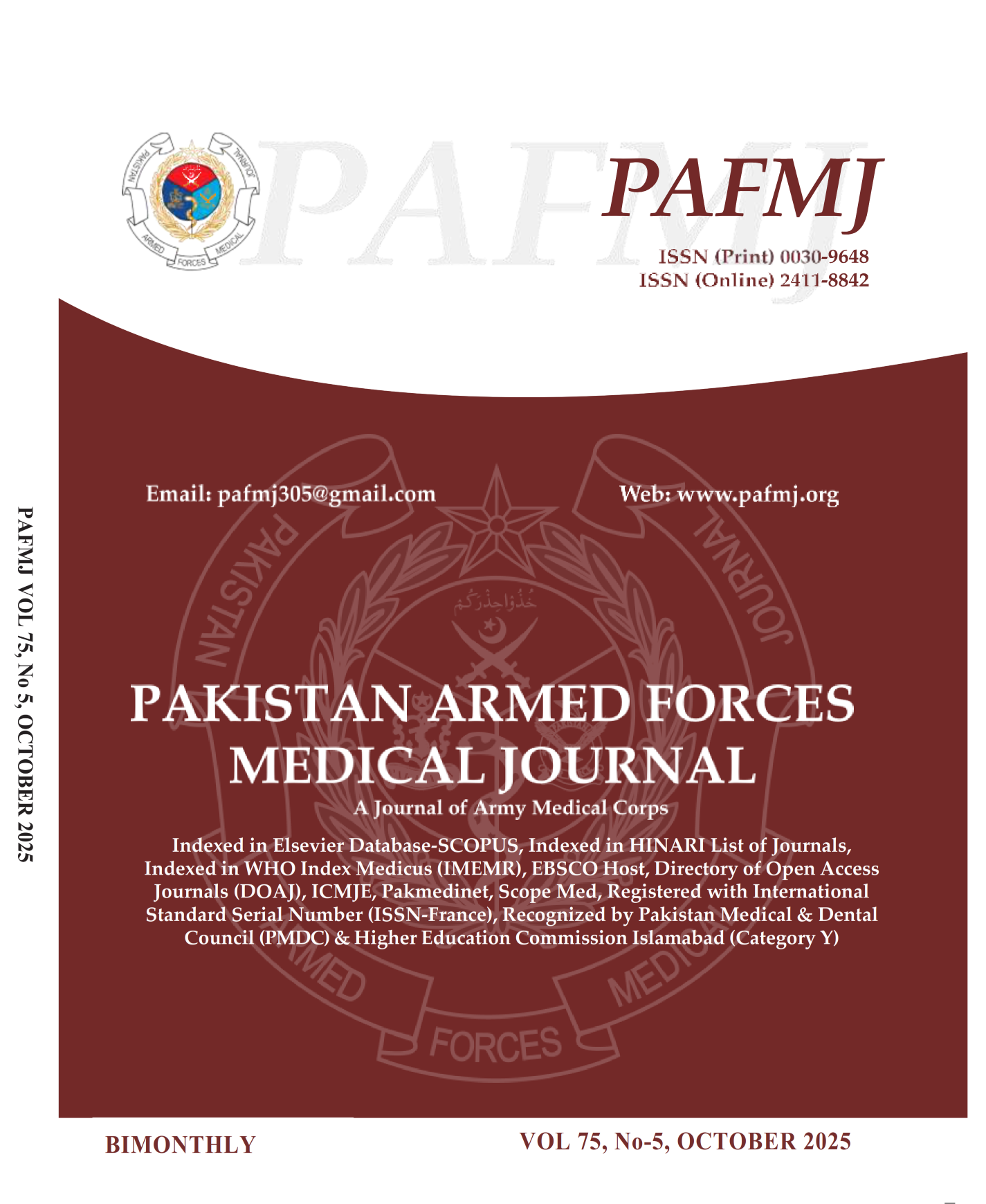Impact of Footwear Practices on Reducing Bacterial Contamination in Operating Theatres: A Quasi-Experimental Study
DOI:
https://doi.org/10.51253/pafmj.v75i5.10889Keywords:
Bacteria, Contamination, Culture, Footwear, and Operation TheatreAbstract
Objective: To measure the frequency of bacterial growth on cultures from the operating theatre before and after the application of infection control practices related to footwear.
Study Design: Quasi-experimental study
Place and Duration of Study: Anesthesiology Department, Combined Military Hospital, Quetta, Pakistan, from Jan 22 to Jan 23.
Methodology: The sample size of 198 was computed with the help of the WHO sample size calculator. The data of 99 samples was collected retrospectively (before improving practices) for five months and prospectively (after improving practices) for seven months. Randomization was done in two groups (B&A). The frequency of positive cultures was calculated before and after improvement of footwear practices and was analyzed through a chi-square test.
Results: A Total of 198 samples were taken from six operating theatres throughout the year. 34(17.7%) cultures came positive with different pathogens, which were included in the statistics. The frequency of pathogens was higher, 27(13.36%), before the improvement of practices and was lower, 7(3.5%) afterwards, with a p-value of 0.001.
Conclusion: This study highlights the significance of footwear practices in minimizing bacterial contamination within operating theatres. The intervention demonstrated that simple, cost-effective measures can enhance infection control.
Downloads
References
1. Tolera M, Abate D, Dheresa M, Marami D. Bacterial Nosocomial Infections and Antimicrobial Susceptibility Pattern among Patients Admitted at Hiwot Fana Specialized University Hospital, Eastern Ethiopia. Adv Med 2018; 2018: 2127814.
https://doi:10.1155/2018/2127814
2. Najotra DK, Malhotra AS, Slathia P, Raina S, Dhar A. Microbiological Surveillance of Operation Theatres: Five Year Retrospective Analysis from a Tertiary Care Hospital in North India. Int J Appl Basic Med Res 2017; 7(3): 165-168.
https://doi:10.4103/ijabmr.IJABMR_281_16
3. Gebremariam TT, María AF. Operating theaters as a source of nosocomial infection: A systematic review. Saudi J Health Sci 2014; 3: 5-8.
https://doi:10.4103/2278-0521.130196
4. Pishori T, Siddiqui AR, Ahmed M. Surgical wound infection surveillance in general surgery procedures at a teaching hospital in Pakistan. Am J Infect Control 2003; 31(5): 296-301.
https://doi:10.1067/mic.2003.7
5. Badia JM, Rubio-Pérez I, López-Menéndez J, Diez C, Al-Raies BB, et al. Spanish Observatory of Surgical Infection. The persistent breach between evidence and practice in the prevention of surgical site infection. Qualitative study. Int J Surg 2020; 82: 231-239. https://doi:10.1016/j.ijsu.2020.08.027
6. Gupta A, Anand AC, Chumber SK, Sashindran VK, Patrikar SR. Impact of Protective Footwear on Floor and Air Contamination of Intensive Care Units. Med J Armed Forces India 2007; 63(4): 334-336. https://doi:10.1016/S0377-1237(07)80009-8
7. Amirfeyz R, Tasker A, Ali S, Bowker K, Blom A. Theatre shoes - a link in the common pathway of postoperative wound infection? Ann R Coll Surg Engl 2007; 89(6): 605-608.
https://doi:10.1308/003588407X205440
8. Frederick, David J. "Hospital Footwear as a Vector for Organism Transmission" (2020). Honors Undergraduate Theses 706. [Internet]. Available from:
https://stars.library.ucf.edu/honorstheses/706
9. Ansari S, Hassan M, Barry HD, Bhatti TA, Hussain SZM, Jabeen S, et al. Risk Factors Associated with Surgical Site Infections: A Retrospective Report from a Developing Country. Cureus 2019; 11(6): e4801. https://doi:10.7759/cureus.4801
10. Zheng ZQ, Liu YY, Luo WW, Zhang HW, Wang YY, Wang H, et al. [Investigation and factor analysis of postoperative surgical site infections in emergency abdominal surgery in China from 2018 to 2021 based on Chinese SSI Surveillance]. Zhonghua Wei Chang Wai Ke Za Zhi 2023; 26(9): 827-836.
https://doi:10.3760/cma.j.cn441530-20230619-00216
11. Ali Z, Qadeer A, Akhtar A. To determine the effect of wearing shoe covers by medical staff and visitors on infection rates, mortality and length of stay in Intensive Care Unit. Pak J Med Sci 2014; 30(2): 272-275.
12. Rashid T, VonVille HM, Hasan I, Garey KW. Shoe soles as a potential vector for pathogen transmission: a systematic review. J Appl Microbiol 2016; 121(5): 1223-1231.
https://doi:10.1111/jam.13250
13. Nwankwo EO, Akande AO. Contaminated operating theatre footwear: a potential source of healthcare-associated infections in a northern Nigerian hospital. Int. J Infect Control 2015; 11(1). https://doi.org/10.3396/ijic.v11i1.13409
14. Burnett SL, Egland SJ, McKelvey PJ, Cook FK. Chemical decontamination of footwear soles to limit microbial transfer in a dry environment. Food Protection Trends 2013; 33: 74-81.
15. Tateiwa T, Masaoka T, Ishida T, Shishido T, Takahashi Y, Yamamoto K. Impact of surgical clothing and footwear on operating room contamination during standstill and intraoperative stepping motion. J Orthop Surg 2020; 28(3): 2309499020976232. https://doi:10.1177/2309499020976232
16. Bonnet M, Lagier JC, Raoult D, Khelaifia S. Bacterial culture through selective and non-selective conditions: the evolution of culture media in clinical microbiology. New Microbes New Infect 2019; 34: 100622. https://doi:10.1016/j.nmni.2019.100622
17. Nnachi RC, Sui N, Ke B, Luo Z, Bhalla N, He D, et al. Recent progress on biosensors for rapid detection of bacterial pathogens in water, food and environment. Environ Int 2022: 107357.
https://doi.org/10.1016/j.envint.2022.107357
18. Shukla A, Srivastava S, Srivastava A, Srivastava T. Surveillance of Microbiological Environment of Operation Theaters. Cureus 2021; 13(12): e20525. https://doi:10.7759/cureus.20525
19. Lambe KA, Lydon S, Madden C, Vellinga A, Hehir A, Walsh M, et al. Hand Hygiene Compliance in the ICU: A Systematic Review. Crit Care Med 2019; 47(9): 1251-1257.
https://doi:10.1097/CCM.0000000000003868
Downloads
Published
Issue
Section
License
Copyright (c) 2025 Muhammad Farooq, Muhammad Tanvir Ahmad Qureshi, chaudhry Amjad Ali, Kaswar Sajjad Ansari, Kaukab Majeed, Hamid Iqbal

This work is licensed under a Creative Commons Attribution-NonCommercial 4.0 International License.















